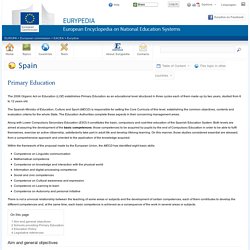

Aprender, Crecer y Pensar: Comparación LOMCE-LOE. CCOO_COMPARATIVA_LOE-LOMCE. ANPE Albacete Castilla - La Mancha. Analysis of the loe and lomce in relation to information and communication technologies by BeaLg. Spain:Administration and Governance at Local and/or Institutional Level. The 1978 Spanish Constitution established a model of decentralised State by which educational powers are shared between all levels of government.

It is a symmetrical model, where the educational powers exercised are basically the same in each and every Autonomous Community. The competences in terms of education are shared between the State General Authority (Ministry of Education, Culture and Sport) and the Autonomous Communities (Regional Ministries or Departments of Education). Spain:Primary Education. The 2006 Organic Act on Education (LOE) establishes Primary Education as an educational level structured in three cycles each of them made up by two years, studied from 6 to 12 years old.

The Spanish Ministry of Education, Culture and Sport (MECD) is responsible for setting the Core Curricula of this level, establishing the common objectives, contents and evaluation criteria for the whole State. The Education Authorities complete these aspects in their concerning management areas. Along with Lower Compulsory Secondary Education (ESO) it constitutes the basic, compulsory and cost-free education of the Spanish Education System.
Both levels are aimed at assuring the development of the basic competences: those competences to be acquired by pupils by the end of Compulsory Education in order to be able to fulfil themselves, exercise an active citizenship, satisfactorily take part in adult life and develop lifelong learning.